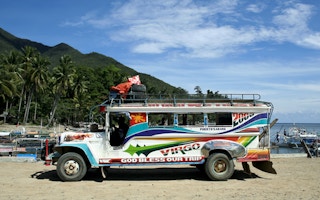Palawan will soon be home to the Philippines’ largest micro-grid solar power plant, generating 1.3 megawatts of clean renewable energy.
Costing P325 million, the plant will have 5,000 solar panels that will provide power to over 600 customers — homes, businesses and hotels — in Puerto Princesa City’s Sabang district. It will also have a battery pack, the largest in the ASEAN region, that will release stored energy during heavy cloud cover or bad weather.
To put that in perspective, a mobile phone battery has about 4.6 watthours, while the Sabang plant’s battery pack is 782,000 times bigger, packing 3,600,000Wh.
To provide nighttime power, the plant will also be equipped with diesel generators that can produce 1 MW of electricity. Atem Ramsundersingh, chief executive officer of Singapore-based WEnergy Global, said the generators will run on diesel fuel for the meantime. WEnergy has a 40-per cent stake in the project.
“Hopefully these machines will run on biodiesel in the near future to get a full clean system. We cannot use biodiesel now as it is much more expensive than normal diesel,” said Ramsundersingh. “But the power plant is designed in such a way that we will use about 50 per cent solar/battery and 50 per cent diesel which brings our power plant close to carbon neutral: no pollution!”
The plant will be operated by Sabang Renewable Energy Corporation, a joint venture between local company Delta-P Inc, a company that runs diesel power plants in Palawan, and WEnergy, which provides the solar energy expertise.
“
Hopefully these machines will run on biodiesel in the near future to get a full clean system. We cannot use biodiesel now as it is much more expensive than normal diesel. But the power plant is designed in such a way that we will use about 50 per cent solar/battery and 50 per cent diesel which brings our power plant close to carbon neutral: no pollution!
Atem Ramsundersingh, CEO, WEnergy Global
Ramsundersingh said they are currently in the final stages of doing the necessary paperwork. The plant, which will provide power to Sabang via a 15-kilometer micro-grid, is expected to be completed by September. The grid will have “smart” meters and offer low and high tariffs to encourage users to use solar power more than diesel at night.
“This project came to us through our good relations with local and national leaders who are aware of global warming and want to keep the Philippines’ contribution to climate change relatively small,” said Ramsundersingh. “It is a lucky confluence of local green and clean awareness and national/international action-leadership against global warming that initiated this project.”
Home to pristine beaches, sea turtles and the world famous Puerto Princesa Underground River, about 50 kilometers north of the provincial capital, Palawan is often seen as the Philippines’ last eco-tourism frontier. It is also the jump-off point for scuba divers traveling to Tubbataha Reef, 150 kilometers southeast of Puerto Princesa.
However, despite being a top tourism destination, Palawan is beset with a power shortage, with daily outages that sometimes last up to 10 hours. The irony is that Palaweños pay double for electricity — P12 kwh compared to P6 kwh in Metro Manila. Because Palawan is not connected to the national grid, power is produced by diesel plants.
Despite the power shortage, local residents, aware that the province relies heavily on eco-tourism, have protested against a planned coal-fired plant by DMCI Power Corporation in Aborlan town.
With the island’s ecosystems and climate change in mind, Palawan’s provincial government is aiming to produce 100 per cent of its energy needs from green renewable sources.
That can be done, said Ramsundersingh, citing Germany as one bright spot in the drive to use solar power. In 1998, only five per cent of Germany’s energy needs came from clean renewable energy. In 2012, that has grown to 22 per cent, with solar plants producing up to 45 gigawatts. Coal use went down from 22 per cent to 19 per cent.
“It truly requires clear decisions and leadership at all levels to make such shifts to remove political, economic and financial obstacles, and to put in place new rules and regulations that would create an enabling environment for renewable technologies to grow and to create thousands of new jobs. This has enabled Germany to enjoy on a bright sunny day the 45 percent of power in the grid to be solar power,” said Ramsundersingh.
Another factor that makes solar power plants attractive for Palawan is that they are faster to build. “For example, a 30-MW solar power plant can be built in less than six months, while its equivalent in hydro or geothermal power could require more than six years,” he said. “Its diesel or gas equivalent could be installed in a short period of time, while a coal-fired plant would require two to three years.”
WEnergy is currently looking into the feasibility of a 4MW solar power plant in Davao City, as well as other similar micro-grid projects in other areas of Palawan.
According to WEnergy, global investments in renewable energy increased 17 per cent to a new record of $257 billion in 2011. Emerging economies made up 35 per cent of this total investment, compared to 65 per cent for developed economies. “So we are certainly seeing a green growth trajectory in the power sector, even if we have quite some way to go to achieve an energy mix that is truly sustainable,” Ramsundersingh said.
It takes political will and money to shift to solar power, but Ramsundersingh said their “biggest challenge is to shift the minds of government and corporate decision-makers and academia towards understanding that renewable energy can be done and must be done.”

















